Finding the Volume and Surface Area of a Cylinder
If you have ever seen a can of vegetables, you know what a cylinder looks like. A cylinder is a solid figure with two parallel circles of the same size at the top and bottom. The top and bottom of a cylinder are called the bases. The height [latex]h[/latex] of a cylinder is the distance between the two bases. For all the cylinders we will work with here, the sides and the height, [latex]h[/latex] , will be perpendicular to the bases.

volume and surface area of a cylinder
For a cylinder with radius [latex]r[/latex] and height [latex]h[/latex]:

For a cylinder, the area of the base, [latex]B[/latex], is the area of its circular base, [latex]\pi {r}^{2}[/latex]. This is different from the area of the base for rectangular solids.
How did we come up with the two equations above?
Seeing how a cylinder is similar to a rectangular solid may make it easier to understand the formula for the volume of a cylinder.
For the rectangular solid, the area of the base, [latex]B[/latex] , is the area of the rectangular base, length × width. For a cylinder, the area of the base, [latex]B[/latex], is the area of its circular base, [latex]\pi {r}^{2}[/latex]. The image below compares how the formula [latex]V=Bh[/latex] is used for rectangular solids and cylinders.

To understand the formula for the surface area of a cylinder, think of a can of vegetables. It has three surfaces: the top, the bottom, and the piece that forms the sides of the can. If you carefully cut the label off the side of the can and unroll it, you will see that it is a rectangle. (See the image below.) The length of the rectangle is the circumference of the cylinder’s base, and the width is the height of the cylinder.

The distance around the edge of the can is the circumference of the cylinder’s base it is also the length [latex]L[/latex] of the rectangular label. The height of the cylinder is the width [latex]W[/latex] of the rectangular label. So the area of the label can be represented as:

To find the total surface area of the cylinder, we add the areas of the two circles to the area of the rectangle.

The surface area of a cylinder with radius [latex]r[/latex] and height [latex]h[/latex], is:
- volume
- surface area
